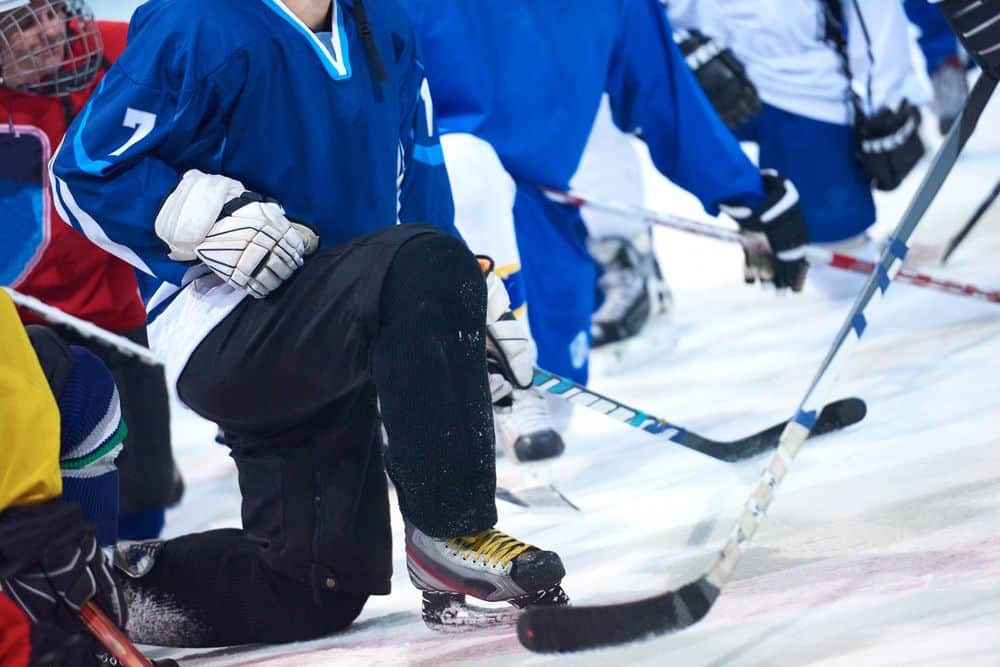The game of hockey has long captivated audiences with its raw intensity and fierce competition. Known for its aggressive and physical nature, hockey thrives on the unbridled aggression displayed by its players.
In this article, we will delve into the factors that contribute to the untamed nature of hockey, shedding light on its origins, the encouragement of aggression in professional leagues, the impact of the hockey rink’s parameters, and the role of equipment in facilitating aggressive behavior.
By exploring these aspects, we aim to gain a deeper understanding of why hockey is renowned for its aggressive style of play. Whether you are a fan, player, or simply curious about the dynamics of this captivating sport, join us as we unravel the intricacies of hockey’s aggressive beast.
Reasons for Hockey’s Aggressive Nature
Driven by a combination of skill and grit, hockey’s aggressive nature stems from the inherent belief that aggressive behavior often leads to more success on the ice. The psychological impact of aggression in hockey cannot be overlooked. Aggressive play can intimidate opponents, disrupt their focus, and create opportunities to score. It instills a sense of fear and uncertainty in the minds of the opposing team, giving the aggressive team a psychological edge.
The role of coaching also plays a crucial role in fostering aggression on the ice. Coaches often emphasize the importance of physicality and assertiveness as key components of a winning strategy. They teach players to channel their aggression in a controlled manner, encouraging them to use their bodies to gain an advantage. Coaches understand that aggression can ignite a fire within the team, boosting morale and creating a sense of unity and belonging.
Origin and History of Hockey
The aggressive nature of hockey can be traced back to its origin and history, which is rooted in violent European games like hurling and shiny. Hockey, as we know it today, evolved from these ancient games, with its own set of rules and regulations.
In the early days of hockey, violence was not only accepted but also encouraged as a means to gain an advantage over opponents. The evolution of hockey rules over time has sought to curb some of the more extreme forms of violence, such as fighting, while still allowing for a physical style of play.
However, the role of violence in early hockey cannot be denied. It was seen as a way to intimidate opponents, protect teammates, and gain an edge in the game. This history of violence in hockey has contributed to its aggressive nature, as players continue to push the boundaries within the confines of the rules.
Nature of a Hockey Rink
A hockey rink’s confined dimensions and limited maneuvering space contribute to the frequent contact and collisions that define the aggressive style of play in the sport.
The small size and tight spacing of a standard ice hockey rink create an environment where players are constantly in close proximity to each other, increasing the likelihood of physical encounters.
This physicality vs. skill dynamic on the rink is a delicate balance between aggression and finesse. To engage the audience further, let’s take a closer look at how the size and layout of a hockey rink contribute to the aggressive style of play:
| Rink Design | Impact on Aggression | Contribution to Style of Play |
|---|---|---|
| Small Dimensions | Encourages physical battles and collisions | Favors aggressive teams with strong physical presence |
| Limited Maneuvering Space | Increases intensity and frequency of contact | Promotes aggressive and assertive play |
| Close Proximity | Enhances opportunity for body checks and physical confrontations | Encourages aggressive behavior to gain an advantage |
| Boards and Glass | Amplifies physicality and aggression | Creates opportunities for big hits and aggressive plays |
The nature of a hockey rink’s design contributes significantly to the aggressive style of play seen in the sport. The confined dimensions, limited maneuvering space, and close proximity between players create an environment where physical battles and collisions are a constant presence on the ice. This balance between physicality and skill defines the aggressive nature of hockey, appealing to those who desire a sport that combines finesse with raw power.
Encouragement of Aggression and Fighting in the NHL
Fighting and aggression are actively promoted and embraced within the National Hockey League (NHL), shaping the untamed nature of the sport.
The encouragement of aggression and fighting in the NHL serves a purpose beyond mere spectacle. It provides teams with a psychological advantage, instilling fear in opponents and establishing dominance on the ice.
The role of enforcers, players specifically designated to engage in physical confrontations, further amplifies this aggression. These enforcers serve as protectors and intimidators, ensuring that their teammates can play without fear of retribution.
The NHL recognizes that aggression and fighting add an electrifying element to the game, energizing the crowd and uplifting teammates.
This encouragement of aggression not only enhances the competitive nature of the sport but also fosters a sense of belonging among players and fans alike, as they revel in the raw, unbridled passion that hockey embodies.
Impact of Hockey Equipment on Aggression
The significant amount of protective equipment worn by hockey players plays a crucial role in facilitating and intensifying the aggressive nature of the sport. The effectiveness of the equipment allows players to engage in aggressive behavior without the fear of injury.
This psychological impact of equipment enables players to push the boundaries of aggression, knowing that they are protected.
The rules and parameters of the game also require the use of protective equipment to ensure safety. This emphasis on safety not only allows players to play more aggressively but also legitimizes and encourages aggressive play within the sport.
The amount of equipment in hockey not only provides physical protection but also contributes to the overall aggressive nature of the game, creating an environment where players can unleash their aggressive instincts.
Frequently Asked Questions
What Are Some Examples of Aggressive Behavior That Is Commonly Seen in Hockey?
Examples of aggressive behavior commonly seen in hockey include checking opponents, which involves using physical force to separate them from the puck, and fighting, which serves as a form of retribution and intimidation on the ice.
How Has the Aggressive Style of Play in Hockey Evolved Over Time?
The aggressive style of play in hockey has evolved over time, driven by the psychological impact it has on players. As the game has become more competitive, aggression has become a key strategy for success.
Are There Any Specific Rules or Regulations in Place to Control Aggression in Hockey?
Rules and regulations are in place to control aggression in hockey. These include penalties for illegal hits, fighting, and unsportsmanlike conduct. Enforcement of these rules by referees and league officials ensures fair play and player safety.
How Does the Aggressive Nature of Hockey Impact Player Safety?
The aggressive nature of hockey poses significant player safety concerns, with the potential for long-term effects. The physicality of the sport, combined with the encouragement of aggression, increases the risk of injuries and impacts the well-being of players.
Are There Any Efforts Being Made to Reduce the Level of Aggression in Hockey?
Efforts to reduce aggression in hockey are being made through rule changes, stricter penalties for dangerous plays, and increased education on player safety. However, finding a balance between maintaining the physicality of the game and ensuring player safety remains a challenge.
Conclusion
In conclusion, the aggressive nature of hockey is deeply rooted in its origins. The sport’s history, coupled with the physicality and intensity of the game, has created a captivating and untamed beast.
This aggression is further encouraged by professional leagues, which prioritize physicality and toughness. Players are often rewarded and celebrated for their aggressive play, leading to a culture that values and encourages this style of play.
Additionally, the parameters of the rink contribute to the aggressive nature of hockey. The confined space forces players into close proximity, increasing the likelihood of collisions and physical confrontations.
Moreover, the equipment used by players facilitates aggression. Pads, helmets, and other protective gear provide a sense of invincibility, allowing players to play with more force and aggression.
Overall, like a roaring fire fueled by passion and adrenaline, hockey’s aggressive style of play continues to captivate and enthrall audiences worldwide.









